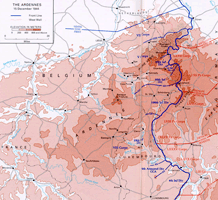| Join | Official Historian | City of Stamford | Blog | About Us | |
| Jewish Historical Society | Civil War Roundtable | Contact Us | |
|
|
|
|
The Stamford Historical Society PresentsPride and Patriotism: Stamford’s Role in World War II
|
 The Ardennes, 15 December 1944 large image |
The Battle of the Bulge, also called Operation Wacht Am Rhein by the Germans (also Ardennenoffensive or Rundstedt-Offensive) and the Battle of the Ardennes by the U.S. Army, began on 16 December 1944 and lasted until 25 January 1945. It was the second to last German offensive of the war, Operation Norwind being the last, that began 1 January 1945. The German goal was to split the Allied line, capture Antwerp and then encircle and destroy four Allied armies. Although the Germans knew they could not win the war, a stunning victory would, in their minds, force Western Allies to negotiate a treaty in the Axis’ favor. The bulge refers to the extent the German forces intruded into the Allied line. Although the offensive failed, it also set back Allied timetables for their own offensives. Germany, however, lost some of its best soldiers during the offensive and it sapped the nation’s ability to supply its forces. In numerical terms it is the largest land battle the U.S. Army has fought to date.
The Allied forces were commanded by General Dwight D. Eisenhower. At the start of the battle the Allies had 83,000 men committed to the field, supported by 242 Sherman tanks, 182 tank destroyers, and 394 pieces of Corps and Divisional artillery. The Germans had some 200,000 troops, 5 armored divisions, 12 2/3 infantry divisions and about 500 medium tanks, supported by 1900 guns. They were under the command of Field Marshal von Rundstedt.
The Allied forces moved rapidly across France after D-Day. Although the French rail system’s destruction as a result of earlier Allied bombing hindered supply efforts, a trucking system known as the Red Ball Express had been set up to keep the offensive moving. In November 1944 the Canadian 1st Army fought the Battle of the Scheldt and took Antwerp. The taking of this port eased supply problems.
The German advance succeeded initially, as it was unexpected and aided by poor weather conditions, however once the weather improved, Allied Air Force attacks helped turn the tide. Eisenhower also treated the attack as a major offensive from the beginning and within a week had transferred 250,000 troops to the area. On 23 December the Allies launched the counter-offensive, which slowly ate away at the German gains. By the end of the battle, the lines were virtually where they had been initially, before the German offensive began.
By the end of the battle the Allies had suffered 80,987 casualties including 10,276 dead, 23,218 MIA and 47,493 wounded. The Germans had 84,834 casualties including 15,652 dead, 27,582 MIA and 41,600 wounded.
| Phil Lodato Stanley Kaslikowski Edward Korn Nathan Norkin George Reiss Murray Weingrad |
From the U.S. Army Center of Military History: The Ardennes: Battle of the Bulge Images of the Battle Ardennes – Alsace |
 Introduction
Introduction
Veterans
Battles
Stamford Service Rolls
Homefront
Exhibit Photos
Opening Day